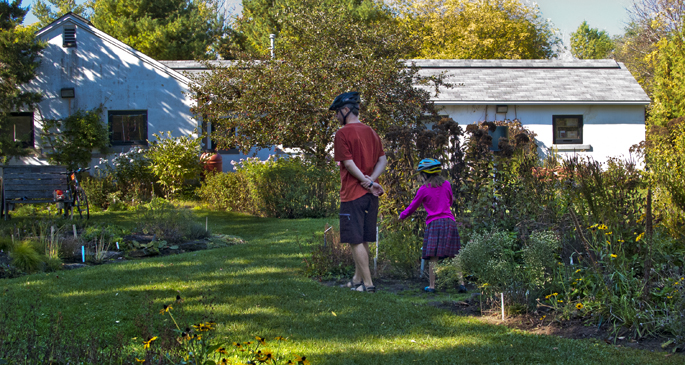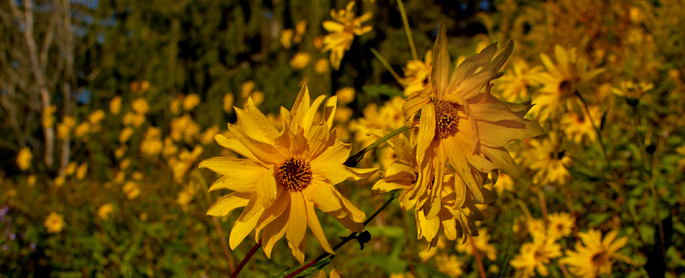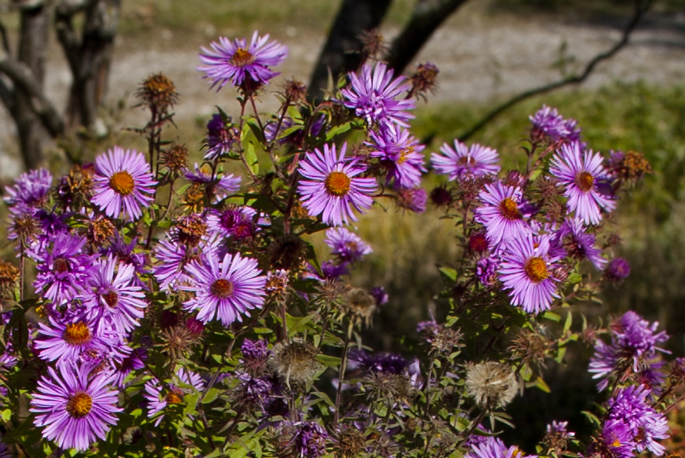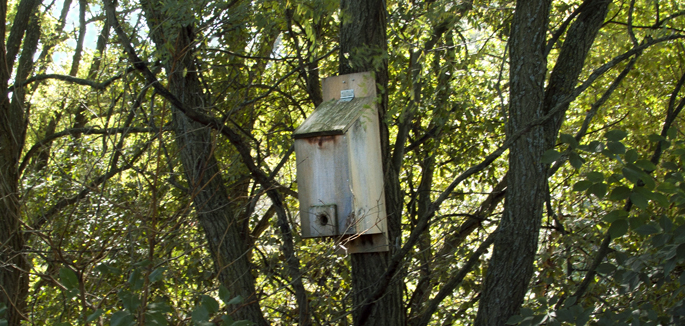Make Your Garden More Wildlife-Friendly
In fall, gardeners everywhere are busy tidying their yards and getting set for the winter. But they are also happily dreaming up plans for the next growing season! My own garden has been in dire need of some revitalization, and I’ve been thinking of trying to take it in a more wildlife-friendly direction. I have a great bird feeder, and a rose the bees love, but there’s definitely some room for improvement.
The news has been full of stories about the falling Monarch butterfly population, which makes me sad, because I used to see them all the time when I was a kid. Not to mention what’s been called the “Beepocalypse” by some: although it looks like the cause of the bee population crash has been figured out. As small as my garden is, it’s great to think an ornamental garden can be used to help, especially for the highly essential pollinators of our food supply!
I got in touch with Sandy Garland of the Fletcher Wildlife Garden, and she kindly agreed to take me on a tour of the garden and answer some of my questions. For those who don’t live in Ottawa, the FWG is part of the Experimental Farm, which is basically a big gorgeous green space right in the middle of the city. Crop research is carried out in the fields, but people go there for special exhibits and events, or just to run or cycle on the paths through the space.
1. When was the Fletcher Wildlife Garden founded, and what was its purpose?
Our web site tells the story: “The idea for a “wildlife garden” began to be tossed around in 1987 when the OFNC wished to celebrate “Wildlife 87”, a Canadian Wildlife Service initiative to focus on wildlife and habitat conservation across the country. Peter and Judy Hall suggested a wildlife garden, a place where people could learn how to garden in a more wildlife-friendly manner, as well as learn about local wildlife. As you can imagine, the idea took hold!”
Peter Hall and Jeff Harrison were the ones who got the project off the ground. Jeff’s enthusiasm, especially, got hundreds of people involved and lots of donations to get started.
2. How did you become involved with the Fletcher Wildlife Garden?
When I was editor of the Old Ottawa South community newspaper, Jeff was writing a monthly column called The Urban Naturalist. He wrote about the FWG and I was intrigued. A few months later, I took a course he was teaching on attracting wildlife to your yard. As part of that, we walked around the future FWG. Again, Jeff’s enthusiasm was contagious and I was “hooked.”
3. Can you tell me about some of the most successful public events you’ve had?
In the early days after we acquired the use of the building that houses our Interpretive Centre, we held a lot of open houses around various themes: Environment Week, International Migratory Birds Day, etc. Although these were moderately successful, we didn’t think we were actually getting any information across and they were exhausting to organize. Instead, we now have closer ties with our parent organization, the Ottawa Field-Naturalists’ Club and encourage their Excursions and Lectures Committee to hold events at the FWG.
Recently, for example, the OFNC and Entomological Society of Ontario held a “Bug Day” at the FWG. There were walks around the garden, but also cockroach races, things like hornworms and scorpions to look at up close, crafts, etc. Hundreds of people participated and it was a LOT of fun.
Our plant sale is our own best public event. It’s grown enormously since the first years, when we would just divide our surplus plants for sale. Now we grow about 1000 plants from seeds collected in our garden and in the wild. It’s introduced hundreds of people to native species and it’s become a good fundraiser for the FWG.
4. What are some of the most interesting animals you’ve seen in the FWG?
The most recent is a garter snake. Maybe not all that interesting, but I never expected a snake to make its way to a garden in the middle of the city.
Foxes live on the Farm and regularly patrol the FWG. We don’t see them often, but their tracks are clearly visible in winter. We’ve also had deer visit on a couple of occasions. One year, a weasel tried to move its babies into our centre’s door frame. It realized quickly that this was not a good idea (the metal frame became too hot), but we all got a good look at this elegant little creature.
5. How and why did the garden become a Monarch Butterfly Waystation?
The Evergreen Foundation invited us to apply for a substantial grant provided by Fido. While kicking around ideas, we consulted Peter Hall, who is a well-known butterfly expert. We wanted to do something at the FWG, but also try to encourage other people to do something for monarch conservation. The FWG already qualified as a waystation as we had milkweeds and a variety of nectar plants. But we’re creating a “model waystation” in our Butterfly Meadow to demonstrate how anyone can plant the sorts of flowers that will help monarchs, other butterflies, and other pollinators.
We’re still not very good at outreach, but we’re working on it.
6. How could I create a butterfly garden in my backyard?
Every gardener wants a garden with lots of colour all summer. Aim for that by planting a variety of flowers that produce nectar and bloom at different times during the year. Now you’ve got the equivalent of a butterfly coffee shop.
If your yard is very sunny, butterflies will stay longer. If you plant larval food plants (you’ll have to do some research to find out what local butterflies want), then they’ll stay even longer and lay eggs on those plants. Now you have a butterfly motel.
Make sure your butterfly garden is sheltered from the wind, add a puddle of water, some “basking spots” – stones or wooden structures, and you’ve got a 5-star resort.
You can learn more about butterfly gardens here.
7. What are some of the easiest things a homeowner can do to make their yard more attractive to wildlife in general?
Add a water feature. Everything needs water and birds especially will come flocking in. If you can make the water move or splash, all the better because birds will hear it from a distance. You can learn more about this on our website.
8. Is there anything we should stop doing in our gardens because it’s hurting wildlife?
Stop using chemicals of any kind – based on the latest news about neonicotinoids, I don’t think we really know about the long-term effects of many chemicals we use. Keep cats inside. Make sure birds are not going to mistake your picture window for open sky.
9. What are some things we can do to make our yards more bird-friendly?
Our website has a page dedicated to creating a safe garden for birds.
10. What’s the best time of year to visit the FWG?
Anytime. In winter, you can see bird and squirrel nests in trees and follow tracks in the snow. In spring, the migratory birds come back and the garden comes alive with their calls, spring wildflowers, and flowering shrubs. In summer, the Butterfly Meadow and Amphibian Pond are both bursting with life. In fall, squirrels and chipmunks are running around getting ready for winter, migratory birds are moving through and using the feeders, and fall leaves and fruit give the whole garden a warm sunny look – even when it’s raining.

Visitors learning how a garden full of native, wildlife-friendly species can make for a beautiful garden. It’s all about the design.
11. Is there anything else you’d like to share about your experiences with the Fletcher Wildlife Garden?
I’ve been a volunteer at the FWG for over 20 years now, and I still learn something new every day I go there. I love talking to visitors because they are usually learning something about wildlife too and it’s neat to share information and experiences.
Sandy’s Special Tips:
- If you want to grow milkweed for Monarch butterflies, don’t dig it up from the wild! The FWG sells seedlings every year at their plant sale.
- If you find regular milkweed too messy for your garden, try Swamp Milkweed, a relative (which likes damp conditions) or Butterfly weed. Both are tidier in a garden setting.
- When planting trees and other plants, opt for native varieties. For example, the popular Norway Maple, while resistant to pollution, casts such a deep shadow that undergrowth plants can’t take root in its shade. Try a native Sugar Maple instead – you’ll also get great fall colours!
What will happen in my garden next year? I don’t know for sure yet, but I have the winter to think about it! Do you have any advice on wildlife-friendly gardening?
By Jennifer Priest





I completely agree Katherine - the garden is very magical place! I'd love to go back in the summer and…